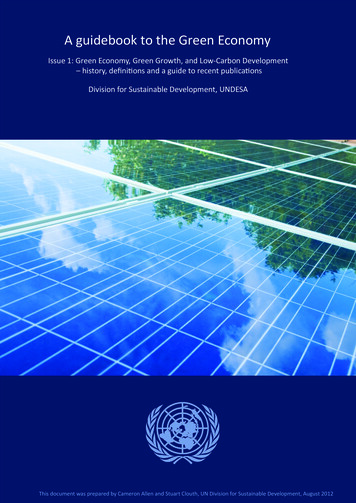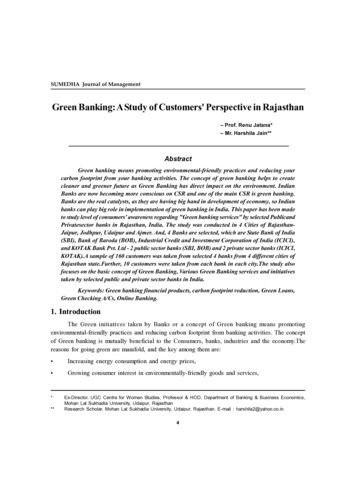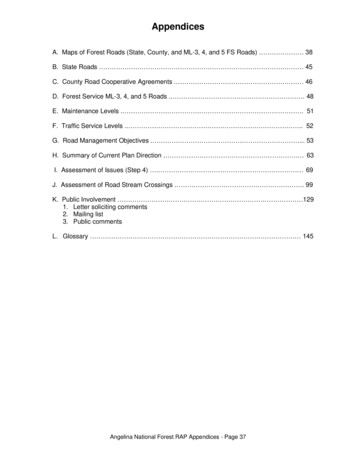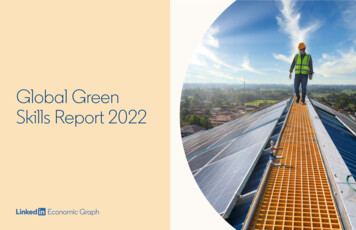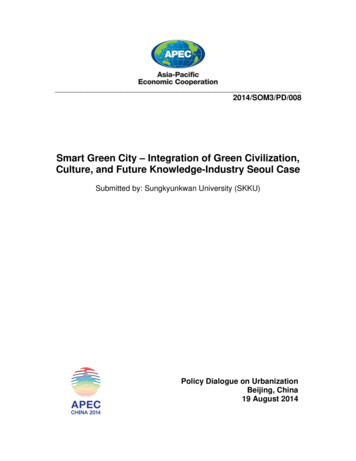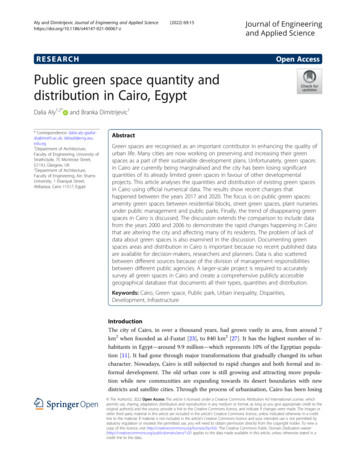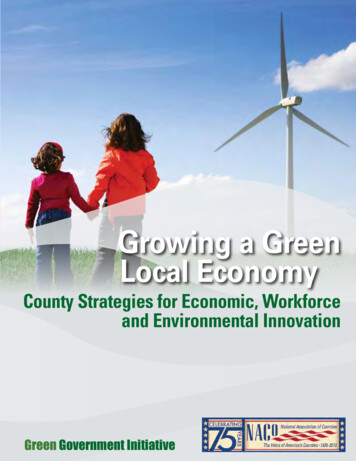
Transcription
Growing a GreenLocal EconomyCounty Strategies for Economic, Workforceand Environmental InnovationGreen Government Initiative
National Association of CountiesGrowing a GreenLocal EconomyCounty Strategies for Economic, Workforceand Environmental InnovationGreen Government InitiativeAbout NACo – The Voice of America’s CountiesThe National Association of Counties (NACo) is the only national organization that represents county governments in the United States. Founded in 1935, NACo provides essential services to the nation’s 3,068 counties. NACo advances issues with a unified voice before the federalgovernment, improves the public’s understanding of county government, assists counties in finding and sharing innovative solutions througheducation and research, and provides value-added services to save counties and taxpayers money. For more information about NACo, visitwww.naco.org.
To request copies of this publication or other related materials about NACo’s Green Government Initiative, please contact:Jared LangProgram Manager, Green Government InitiativeNational Association of CountiesPhone: (202)942-4224E-mail: jlang@naco.orgThis issue brief was published in May 2010 and made possible by the generous support of NACo’s Green Government Initiative Partners andthe U.S. EPA’s ENERGY STAR Program. It was written by Jared Lang, NACo Green Government Initiative Program Manager, with contributionsfrom several NACo staff, including Stephanie Osborn, Anita Cardwell, Cindy Wasser, Carrie Clingan, and Erik Johnston, and several NAComember counties. Jack Hernandez performed the graphic design and layout. Several photos used in the publication are courtesy of GreenJobs Now.The report assembles a wide breath of research and analysis from across the non-profit, academic, and business communities. To follow upon the concepts and strategies highlighted in this document, please refer to the list of sources cited in the back of this publication.
Growing a Green Local Economy:County Strategies for Economic, Workforce andEnvironmental InnovationWith new policy attention and investment flowing into “green”economic activity, opportunities are arising for counties to position their communities to take part in the green economy. Pursuinggreen economic growth is paying off for local governments aroundthe country. Between 1998 and 2007, “green” jobs grew at a fasterrate than overall jobs. All sectors of our economy have been hit bythe recession, but investments in green technology have fared farbetter than conventional investments. Looking forward, the greeneconomy presents significant growth opportunities for America’scounties.1 This guidebook serves as a resource for counties interested in understanding their role in the green economy and tappinginto its tremendous potential.What is the Green Economy?The concept of a “Green Economy” is quite new. As such, communityand industry leaders have not settled on one clear definition of thegreen economy. On one end of the spectrum, definitions limit thegreen economy to simply the clean energy industry. While on theother end of the spectrum, definitions include the greening of everysingle economic input.Despite the disparity in definitions, leaders working on green economic issues agree that it represents the confluence of economicdevelopment, workforce development, and environmental stewardship. Green economic practices are unique in that they encourage county economic development and workforce departments toaccount for the environmental impacts of their decision-making,while environmental departments are encouraged to account forthe ways their policies effect economic growth and job creation.The concept is predicated on the idea that economic prosperity andenvironmentalism should be mutually beneficial.Defining the Green Economy: A Primer on Green Economic Development, an analysis of 25 separate studies on the green economy, offers perhaps the clearest definition of the green economy. At its core,the green economy is the clean energy economy, consisting primarily of four sectors: renewable energy (e.g. solar, wind, geothermal);green building and energy efficiency technology; energy-efficient infrastructure and transportation; and recycling and waste-to-energy.2Although these are the growth sectors leaders primarily focus on, thegreen economy is not just about the ability to produce clean energy.“To remain competitive in the global economy,we need to discard notions of a dichotomy betweeneconomic growth and environmentalismand position our local economies at the forefrontof innovation, competitiveness, and wiseenvironmental stewardship.”– Valerie BrownNACo President, Supervisor, Sonoma County, CAThe green economy also includes retrofitting existing products andprocess improvements that result in efficiency and positive environmental impacts.What are theSectors of the Green Economy?The integration of economics and environmentalism creates severalnew industry sectors and requires the re-evaluation of many existingproduction consumption processes. The sectors impacted by greeneconomic development vary depending on how stakeholders definethe green economy. Figure 1 illustrates a green economic sector analysis adapted from Defining the Green Economy: A Primer on GreenEconomic Development.County Strategiesfor Greening Local EconomiesEach county has unique challenges that require different approachesto greening their local economy. In order to best meet the needs ofNACo members, strategies for impacting the green economy can bebroken down into five broad categories:Green Economic DevelopmentResource Efficiency and Green PurchasingLocal ProductionWaste ManagementGreen InfrastructureThe strategies and implementation tools are described in further detail in the following sections. But before delving into the 5 strategies,it should be noted that three overarching themes run across them all.
Figure 1: Sectors of the Green EconomyTraditionalNewIndustries (production)Lifestyle (Consumption)Cleantech R&Dresearch and product development for energy generation andstorage, transport, nanotech, smart production, etc.Energy and Utilitieselectric, gas, water, etc.Eco-Tourismtrip guides, hotels, etc.Cleantech Manufacturingproducing environmentally sensitive, low-emissions, and/or energy efficient products (e.g. photovoltaics)Green Buildingon-site construction, solar panel installation, retrofits, HVAC,housing materialsOrganic Gardeningpruning, yard work, landscaping, etc.Other Green Manufacturingenergy-saving appliances, packaging, green furniture, othermanufacturing using green processes, etc.Waste Managementrecycling, composting, biomass, etc.Ecosystem/Park Managementtrail maintenance, erosion, prevention, invasivespecies, removal, etc.Sustainable Food Processingbaked goods, energy bars, tea and coffee, prepared food, etc.Chemistry and Materialsbrownfields cleanup, less polluting/hazardous chemical processes, etc.Retailrestaurants, farmer’s markets, groceries, cleaningproducts, clothing, appliances, cars and bikes, etc.Green Financial Servicesventure capital, investment and commercialization services fornew green technologiesTransportationvehicle and component mfg, biofuel stations, operations, maintenance and repair, etc.Other “Greened” Establishmentstraditional service firms that are greening operations (legal services, government, etc.)Urban Goods Movement Systemsfreight, warehousing, etc.Number of reportsmentioning sectorEnvironmental Servicesenvironmental impact reports, environmental law services, civilengineering, architecture, planning, etc.24–2518–2212–151–50Figure 1 is adapted from Defining the Green Economy: A Primer on Green Economic Development. It illustrates the economic sectors most commonly included into thegreen economy. The key highlights the frequency with which studies performed by industry and public sector leaders included specific sectors. The vertical axis organizesthe sectors from traditional economic practices undergoing changes due to the integration of economic and environmental goals to sectors that are now emerging. Thehorizontal access organizes the sectors from production to consumption activities.RetrofitThe least costly and most efficient way to go “green” is to retrofit existing systems and processes to utilize existing resources more efficiently.Grow “Green”Growth provides a crucial opportunity to incorporate green from theground up. All production systems can be examined and altered togreen standards.Consume “Green”The consuming of products, services, and food has numerous economicand environmental impacts. When purchasing everything, consumerscan make efforts to ensure products are produced efficiently and withthe least impact to the environment.By its nature, green economic development results in manysocial and environmental benefits. For the sake of clarity andbrevity, this report focuses almost exclusively on the strategiesand economic benefits accruing from the integration of localeconomic and environmental activities.Green Economic DevelopmentTraditional economic development focuses on increasing productionof goods and services. Production and exportation are vital for generating local income. Consequently, building export bases dominatesmuch of traditional economic development strategies. In a greeneconomy, traditional economic development strategies are adaptedto build business that improves environmental outcomes.Green Business Attraction and RetentionKey targets for green economic development commonly includebusinesses that manufacture components for clean energy generation, perform clean energy and technology research and develop-ment, and produce new environmentally-friendly versions of traditional products.Attracting new green business is believed to be most substantialstrategy for developing green local economies. Yet, high initial costsfor site relocation, research, development, and marketing of greenproducts and services often prevents the private sector from expanding.3 With that in mind, county government can develop a greeneconomic development strategy that targets incentives to greenbusinesses and reduces barriers of entry into their communities.Model ProgramOhio Green Enterprise ZoneClinton County/City of Wilmington, OHOn July 16th, 2009 the City Council of Wilmington, Ohio unanimously voted to establish the Wilmington Green Enterprise Zone(GEZ)–the first of its kind in the country. Funded as a line itemof the City of Wilmington budget, GEZ is an innovative policytool that seeks to spur green business and job creation in Clinton County by bringing about a convergence of two key areasof economic development: local capacity building and targetedfinancial incentives. In addition, Clinton County will: Serve as a consultant to parties seeking resources at the local,state, and federal levels. Provide an annual report on regarding the activity andagreements within the GEZ and advise the Mayor ofWilmington and Wilmington City Council on greendevelopment issues. Provide Green Enterprise Grants (GEG) for qualifyingprojects that improve material and energy efficiency ordeploy advanced energy technologies for new or existingbusinesses.4
Counties commonly take advantage of several strategies to attractgreen businesses: Expedited review processes Technical support (e.g. with finding real estate, financing, landdevelopment review processes, etc.) Assistance with outside grants, loans, and support In-kind contributions (e.g., of land or infrastructure or staff support) Paying relocation expensesIn addition, several strategies are designed to both attract and retaingreen businesses. Grants for targeted green ventures Tax credits and refunds for targeted green businesses Fee exemptions for local government processes (e.g. landdevelopment review, building renovation, etc.) Subsidized loansGreen Economic GardeningEconomic gardening is an economic development model that embraces the fundamental idea that entrepreneurs drive economies.The model seeks to create jobs by supporting existing companies ina community and helps community members develop new businesses. The concept connects entrepreneurs to resources, encouragingthe development of essential infrastructure and providing them withneeded information. Economic gardening initiatives provide local entrepreneurs with access to competitive intelligence on markets, customers, and competitors comparable to the resources customarilyonly available to large firms. This type of development increases localcapital and provides income to residents who are likely to stay in thecommunity for the long term. Traditional economic gardening can beadapted to target green business sectors. Services can include: County-supported business counselors Customized business research Market trends Industry information Customer analysis and identification Demographics and psychographics Marketing resources/lists Industry trends/forecasts, business financial info GIS – tools that provide customer locations and trends, drive-timeanalysis, plot competitor locationsGreen Jobs and Workforce TrainingBefore making location decisions, green businesses examine localdemographics to determine whether communities offer the bestemployee-bases to support their staffing needs. In order to attractand retain green businesses, counties need well-trained workforces.Counties leading the way in green economic development have harmonized workforce training and economic development programsto accelerate green economic outcomes. By analyzing the employment needs of existing green businesses and new businesses counties want to attract, they can develop workforce training programs totrain workers for available jobs.Green jobs may be new, but most are achievable by transforming existing roles and retraining workers. The newly created White HouseTask Force on Middle Class Working Families defines green jobs asjobs that 1) involve tasks associated with improving the environment; 2) provide sustainable family wages, health and retirementbenefits, and decent working conditions; and 3) are available to di-Model ProgramsPueblo County EconomicGardening ProgramPueblo County, COThe Pueblo County, Colo., Geographic Information Systems (GIS)Department offers consulting services for local businesses to helpthem find optimal locations and grow in the community. The GISdepartment uses software from Redlands, Calif.-based ESRI thatsupports a variety of analysis and mapping needs, and providesdemographic, business and shopping center data as well as theability to incorporate in-house data.Christopher Markuson, GIS manager for Pueblo County, and histeam help business owners analyze and map demographic dataand find valuable sources of information to improve their business models. They recently helped a local Web-based businessthat wanted to improve market penetration nationwide andPueblo Community Health with a fundraising campaign. Whenlast studied in September 2009, Markuson said, “We’ve tracked58 new jobs emerging from the businesses we’ve helped grow,bringing in over 2.8 million of new revenue into the county.”Markuson also noted that most of the new jobs paid livable wages ( 45,000 each on average), offered benefits, and had little potential to move out of the community. For more information onthe program, please visit www.pueblobusiness.org.Boulder CountyGreen Jobs PipelineBoulder County, COThe Green Jobs Pipeline Partnership is a collaborative effort ofBoulder County Housing and Human Services, Boulder CountyHousing Authority, Boulder County Community Services andWorkforce Boulder County. The county piloted renewable energy and energy efficient projects for the Boulder County HousingAuthority—providing paid internships and on-the-job trainingfor low-income workers. The process links workforce demandwith training for people in specific sectors—creating a pipelinefrom unemployment to work.The program has weatherized 500 homes throughout Boulder,Broomfield, Larimer & Gilpin Counties—upgraded with cutting edge life/safety and energy efficiency enhancements. Thetraining includes include soft skills, pre-apprenticeship training,and wraparound services that are needed to serve ex-offender,youth and other hard to serve populations. The goal is to buildsustainable public-private partnerships that ensure BoulderCounty residents can find pathways out of poverty. 6verse workers from across the spectrum of race, gender, and ethnicity. In forming these jobs and sectors, county green workforce training strategies and programs should incorporate both the demandfor trained employees and existing supply already available withincommunities.5The National Association of Counties has performed extensive workon green jobs issues. For more information, please refer to NACo’sIssue Brief County Economic Development and Green Jobs: The Roleof County Officials.
Workforce Training PartnershipsBecause the connections between local demographics, existing skills,workforce training, and employment are so complex, effective workforce training requires partnership across communities. For decadeslocal workforce boards have been utilized to foster community partnership. When building partnerships and initiating efforts to trainworkforces for green employment, this is a great place to start. Theseare the common participants in green job training: County and city government leaders State government leaders Non-profit job training organizations Unions Local Businesses Community Colleges UniversitiesStimulating Green-Collar Jobs and Opportunity in theNew Energy EconomyIdentify goalsand assessopportunitiesLeverage successto build politicalsupport for newinitiativesBuildingsThe built environment is a vital component of all economies. Theway homes, businesses, civic institutions, and infrastructure arebuilt, designed, and maintained has broad implications for resourceconsumption. As a result, pursuing resource efficiency in local building stocks can create new jobs and increase counties’ attractiveness.Building energy efficiency measures include: Upgrading mechanical and electrical systems Replacing lighting and lighting controls Adding energy management and information systems Upgrading heating, ventilation and cooling air conditioning (HVAC)systems Incorporating low-flow water fixtures Developing renewable energy capacity Distributed generation Combined heat and power (CHP) Covering roofs with reflective materials Replacing windows Adding insulationCounties can lead by example by performing energy efficiencyupgrades in their own facilities. At the same time, counties canalso leverage their resources by pursuing community-wide energy efficiency strategies that influence local businesses andresidences. For more information see NACo’s Internal CountyEnergy Management Strategies Factsheet.Enact policiesand programs todrive investmentPrepare green-collarworkforce: Training partnerships Pathways outof povertyThe diagram depicts the process by which counties can develop their local green workforces. The cyclical representation illustrates the iterativenature of green workforce development strategies.7Resource Efficiencyand Green PurchasingIn addition to green economic development strategies that increaseproduction and supply, there are additional, often more effective,methods for building green local economies. Resource Efficiency andGreen Purchasing are two broad strategies for addressing the consumption-side of the green economy—harnessing community buying power and demand for energy, water, and green products. Simplyby more efficiently utilizing resources, counties can: Reduce the cost of running local government Reduce the cost of doing business for existing green businesses Lower barriers of entry for new green businesses Reduce utility costs for homeowners, improving communityquality of life and attracting a stronger workforce. Reduce the negative impacts on the environment caused byresource useGreen Building Tools and StandardsA 2008 CoStar Group, Inc. study found that green buildings standardsin the U.S. were “adding value” to buildings, as exhibited in higheroccupancy levels, rents and sales prices as compared to traditional commercial properties.8 Several commonly used tools to greenbuildings include: The U.S. Green Building Council’s LEED Rating System is aninternationally recognized green building certification system,providing third-party verification that buildings and communitiesare designed and built using sustainable strategies.9 National Green Building Standard defines green building for singleand multifamily homes, residential remodeling projects andsite development projects, while still allowing for the flexibilityrequired for regionally-appropriate best green practices.10 ENERGY STAR offers several tools for managing energy use inbuildings. Portfolio Manager is an interactive energy managementtool that allows users to track and assess energy and waterconsumption across their entire portfolio of buildings in asecure online environment. Whether you own, manage, or holdproperties for investment, Portfolio Manager can help you setinvestment priorities, identify under-performing buildings, verifyefficiency improvements, and receive EPA recognition for superiorenergy performance.11 The ENERGY STAR Building Manual is a strategic guide to helpplan and implement profitable energy saving building upgrades.Users can maximize energy savings by sequentially following thefive building upgrade stages.Counties can offer incentives such as density bonuses or expedited review processes (Arlington County, VA), or enact regulations that requirebuildings to meet green building standards (Los Angeles County, CA).For sample incentives and regulations to encourage the use of thesetools, please see the database available at www.greencounties.org.
Energy Efficiency Financing MechanismsWith the challenges local governments are facing, the National Association of Counties understands that it is difficult to find fundingfor green building initiatives. As a result, the Green Government Initiative is dedicating much of its resources to helping counties findnew financing methods. Included are several traditional and newmodels for financing energy efficiency. Counties can apply for grant funding from federal, state andnon-profit sources to fund energy efficiency improvements. Performance Contracting is a model used by counties to payfor energy efficiency upgrades with the savings they create.Loans are taken out up-front and paid off over time with thesavings they create. Property Assessed Clean Energy (PACE) programs enablecounties to loan funds to residents and businesses for energyefficiency retrofits. Proceeds are repaid 20 years via an annualassessment on their property tax bill. Revolving Loan Funds enable counties to create a pool fromtheir existing resources to loan over and over again for energyefficiency retrofits. Loan interest and fees replenish the fundand cover maintenance. Loan Loss Reserves can be set up to back-up traditional loansmade by private lenders—in turn reducing loan interest rates,which makes loans much more affordable and increases thebenefits of making energy efficiency investments.For more information on green building in counties, please see Counties & Commercial Green Buildings Factsheet12 and Counties & Residential Green Building Standards.13 There are also several factsheetsavailable on the models include here at www.greencounties.org.OperationsThe daily operations of both public and private facilities offer aninordinate number of opportunities to increase efficiency. Thesestrategies are just as valuable for creating new jobs and revenuefor local communities as business attraction and workforce development. Often, these strategies take less capital, expertise, andtime to implement. Hence, they the most popular and most oftenpursed strategies.Green ProcurementGreen procurement is the selection of products and services thatminimize environmental impacts. Strategies include: Office Supply Purchasing Policies Green Cleaning Policies Green Building Operations PoliciesFor sample resolutions and purchasing policies, please visit NACo’sGreen Government Database.14Fleet ManagementFleet (vehicle) management can include a range of functions,such as vehicle financing, vehicle maintenance, vehicle telematics(tracking and diagnostics), driver management, fuel managementand health & safety management. Fleet Management provides opportunities to remove or minimize the risks associated with vehicleinvestment, improving efficiency, productivity and reducing overalltransportation costs. For more information on fleet managementstrategies, please see NACo’s Transportation and Alternate FuelsResources at www.greencounties.org.15Local Business Community EfficiencyBy influencing local businesses to reduce energy and water consumption, counties can increase their attractiveness to companiesthat create green jobs and skilled workers. The National Associationof Counties Green Government Initiative has produced several publications on methods for undertaking community-wide energy efficiency—including policies and action plans.Residential EfficiencyBy influencing the reduction of energy and water consumption inhomes, counties can increase resident quality of life and make theircommunities more attractive to the employees that green businesses desire. The National Association of Counties has identified severalstrategies to reduce residential energy and water consumption.Operations Tools and StandardsGreen standards provide defined guidelines for local businesses.Some common standards and regulations include: Green Plus is a program that educates and certifies small andmedium sized businesses in triple bottom line sustainability. Theorganization offers benchmarking tools and strategies for greenbusiness operation and procurement.16 Green Seal offers certification for local businesses looking to greentheir products and services.17 LEED for Existing Buildings Rating System helps buildingowners and operators measure operations improvements andModel ProgramsGreen Business PartnershipSarasota County, FLThe Green Business Partnership is a collaborative effort of businesses, business organizations and county government. It wasinitiated through an innovative grant awarded by the Florida Department of Environmental Protection to Sarasota County. Anon-site certification assessment to verify the performance of applicant businesses to the Green Business Partnership standards.Certification is valid for three years, after which a recertificationprocess is required. Local businesses are seeing noticeable results due to their participation in the program. For example: Carlson Studio Architecture is saving more than 1,600/yearby conserving energy and water Children’s World Uniform Supply reduced its paperconsumption 50 percent Mirasol FAFCO Solar reduced its garbage costs 50 percent . The John and Mable Ringling Museum of Art reduced energyconsumption and saved 100,000/year24
maintenance on a consistent scale, with the goal of maximizingoperational efficiency while minimizing environmental impacts.18 The US Environmental Protection Agency’s ENERGY STARProgram provides many platforms that can be used to leveragecounty resources to promote energy efficiency throughout thecommunity.»»The "Change the World, Start with ENERGY STAR" campaign isdesigned to encourage local residents to pledge with millionsof others to take small, individual steps to conserve energy.Energy Star offers a process for how to set up a competition.19»»Energy Star’s Guidelines for Energy Management offersa proven strategy for superior energy management andfinancial performance with tools and resources to help eachstep of the way.20»»Energy STAR’s Residential Program offers tools and resourcesfor how local residents can improve energy efficiency in theirhomes. The US Environmental Protection Agency’s WaterSense Progamhelps consumers identify water-efficient products and programsthat meet WaterSense water efficiency and performance criteria.WaterSense offers products, programs, and practices to help savewater and money and encourage innovation in manufacturing. Residential Energy Services Network (RESNET) Certified Auditorsprovide Home Energy Rating (HERs) and offer strategies formeeting Energy Star Performance Standards.Local Production and UtilizationProducing and consuming locally builds community wealth, increases regional self-reliance and economic security, and eliminates theenvironmental impacts associated with transporting goods over longdistances. Due to the multiplier effect, the positive impacts of localexpenditures ripple throughout entire local economies. The localeconomic chain works something like this:1. manufactures create jobs by producing goods in a community2. on-site jobs and income are created by distributing and installing thegoods3. and additional jobs and economic activity are created by supplyinggoods and services to people in the primary green activity.More specifically, local manufacturing can produce high quality jobsand export products. Locally-sourced food can provide better qualityfood at a lower cost to communities. Locally-sourced renewable energy can reduce the cost of living for local residents, the cost of doingbusiness for businesses, and create security in the energy supply.Local Food SystemsThe way we produce, process, and consume food has major implications for green economic growth and environmental quality. Theterm "foodshed" is used to examine local food systems in a holistic manner and create more sustainable methods for producing andconsuming food. Foodsheds include everything from where food isproduced to where it is consumed—including the land it grows on,the routes it travels, the markets it goes through, the way its eaten,and its disposal. Many “eat loc
Cleantech Manufacturing producing environmentally sensitive, low-emissions, and/or en-ergy efficient products (e.g. photovoltaics) Green Building on-site construction, solar panel installation, retrofits, HVAC, housing materials Organic Gardening pruning, yard work, landscaping, etc. Other Green Manufacturing
